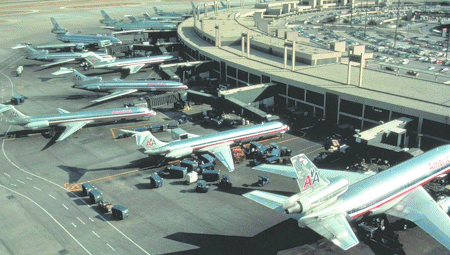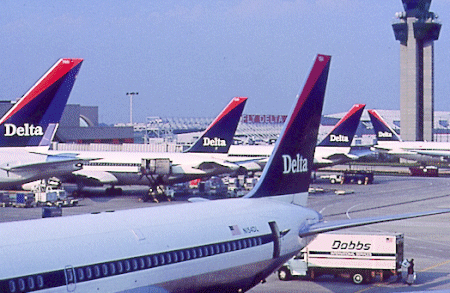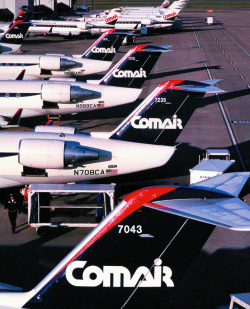The "big three" US airlines - American, Delta and United - may have followed similar paths, but they have different strengths
Chris Jasper/WASHINGTON DC
Since deregulation in 1978 the US airline industry has changed to such a degree that the sector is barely identifiable with that of the pre-liberalisation era. And most notable in this transformation has been the emergence of three huge US carriers, based at three equally titanic US airports.
It would be natural to conclude that United Airlines, American Airlines and Delta Air Lines have each attained 'giant' status by following similar strategies, and to an extent they have. All three have built major hubs and established spoke systems around them (together with secondary and tertiary hubs), all have embarked on the switch from turboprop- to jet-powered regional aircraft fleets, and all are major players in global airline alliances.
Yet beyond these obvious similarities are major differences between the three. The strategies they have pursued, though parallel, mean each has evolved wildly varying strengths and weaknesses, and that each has positioned itself very differently for the challenges of the third decade of the post-liberalisation era. That positioning is now more crucial than ever, in that the rapid change that gripped the US industry throughout much of the 1980s and 1990s has to a degree plateaued, with the hub system now essentially mature. Room for manoeuvre suddenly seems far more restricted, and only moves of the size of United's recent swoop for US Airways are likely to change the landscape radically.
The US "big three" are giants by any reckoning, occupying the world's top three positions for the key parameters of sales (with the occasional challenge from British Airways and Lufthansa), traffic and passenger numbers. American's parent AMR ranks number one by revenue, with its airline and Sabre operations (the latter now spun off) reporting a turnover of more than $20 billion last year. United had the most traffic (more than 200 billion revenue passenger kilometres) and Delta carried the highest number of passengers at nearly 106 million.

The trio's home bases have become three of the world's largest airports because of the airlines' hub-building strategies. Atlanta (Delta), Chicago (United) and Dallas/Forth Worth (American) are the world's three busiest airports in terms of movements, while Atlanta and Chicago also rank one and two in passenger throughput, with Dallas ranking just behind Los Angeles and London Heathrow.
Contrasts between the three have evolved despite their commitment to a common aim that Delta's vice president, network analysis, Douglas Blissit, defines as "getting people from everywhere to anywhere". More precisely, he says "major airline" strategy is aimed at "providing best overall coverage out of core markets and being the airline of choice out of our core cities", adding: "The goal in this industry is to become the carrier of choice to where you fly. If you can create more value for the people in a given city through a range of products and fares - business, leisure and international - you win a disproportionate share of loyalty."

Post-liberalisation, the establishment of core markets has centred on hub-building. Delta, for example, has established four key domestic hubs - Atlanta and Cincinnati, plus Dallas and Salt Lake City - supplemented by international gateways, which it aims to "leverage" further where possible. United's hubs are at Chicago, Denver, San Francisco, Los Angeles and Washington DC, and American's at Dallas, Chicago, Miami and New York. While each airline has areas of geographical strength, there are also areas of major overlap, especially in Chicago and Dallas. It is not so much overlap that determines competition, however, as the connections that can be made via hubs. Two airlines are just as likely to compete for traffic between two given cities by offering services routed via different hubs as they are to compete at a given hub that both use.

Delta, Blissit says, views point-to-point services as supplementing the hub and spoke system. Where there are obvious business opportunities it is prepared to offer service, such as a recently launched New York-Los Angeles morning flight, which offers no connections with transatlantic operations. Its Delta Express low fare business, which operates from the northeast USA to Florida and has grown to operate 44 aircraft, is also a point-to-point service, as is Delta Shuttle, a unit of the mainline airline which specialises in east coast commuter flights. Through it, Delta has become the number one airline in Boston and New York LaGuardia, giving it north-south strength distinct from its east-west hub structure.
With domestic services accounting for 80% of business, international services are not exactly core to US major airline operations, and glaring gaps often exist in coverage. Delta has built New York JFK into the largest international gateway of any US carrier, and offers 16 daily international departures out of Atlanta, giving it strength in Europe and Latin America. Yet, transpacific coverage is much more patchy. "We don't have a significant Asian presence", admits Horton, who hopes that an application for flights to China will help address this problem.
New routes aside, global alliance-building is the most effective tool in eliminating international weaknesses. Codesharing alone increases revenues through ticket sales on flights operated by partner carriers, and more importantly it increases flows into domestic networks via gateway hubs.
Those domestic networks, transformed by the hub-and-spoke system, are themselves undergoing a new revolution with the introduction of regional jets (RJs). As Blissit notes, mature hubs now enjoy a modest growth rate of around 3%, with "most of the operations exploited to the full" - but previously untapped routes opened up by RJs have produced 100% growth over the first few years, and are expected to continue producing 20% growth for at least the next three. Margins are also higher, and predicted to remain double-digit for five years.
Regional jet network and fleet development has again varied from carrier to carrier, with the Delta Connection airlines leading the way, with big Bombardier Canadair Regional Jet orders from 1993, and Continental Express (the biggest Embraer Regional Jet operator, having first placed orders in 1997) and American Eagle relatively close behind. The latter is wholly owned by its parent, unlike other regional operations, and is also the world's biggest regional airline - although it has been slower in making the RJ transition.
Such has been the impact of RJs in increasing feed (Delta is even introducing them to the Caribbean and Central America) that - until the United/US deal - most recent US airline takeover activity focused squarely on consolidating regional airline operations.
Economics has been the prime motivation, with big jet carriers aware that non-owned franchisees will always favour their own shareholders, a problem which can be solved only through takeovers. Revenue management was also a problem, with feeder airlines favouring local services ahead of transcontinental flights which net them a smaller share of the pie.
In the regional market, US scope clause restrictions are the main obstacle to further expansion, and here Delta has an advantage, with a wider-ranging pilot agreement. American, for example, has a 67-aircraft ceiling on regional jets seating 45 people or more, restricting severely its deployment of 50 and 70 seater aircraft. Scope clauses mean that expansion beyond 70 seats will prove difficult, and a 90-seater operated as a mainline aircraft is uneconomic. Many US airline executives nevertheless say such a move is a definite aim.
Secure in their hubs, US carriers have spent the last few years jousting for position by developing secondary networks and introducing regional jets, establishing low-cost operations (though Blissit claims Delta Express is the only fully profitable low fare division of a major airline) point-to-point service where practicable, and expanding international coverage through global alliances.
The only serious departure from this orthodoxy of organic development through steady expansion of service seemed likely to come from industry consolidation - and so it did. Despite their strengths, all three US giants have clear gaps in their armoury, and given the mature nature of the sector in the USA, it will always be easier to close this through acquisitions rather than by expanding into alien territory.
United's agreed purchase of US Airways reflects this fact. Though American admits that it, too, moved for the smaller airline, United's need was greater, because unlike both the Dallas-based carrier and Delta, it lacks any meaningful operation in the eastern USA. Should the deal go through, however, United will have national coverage better than that available to its rivals, and will also be an order of magnitude bigger than them.
This means life has become more complicated for Delta and American, with the status quo under threat and the effectiveness of continued organic growth suddenly in doubt. Retaliatory moves therefore become not just possible but probable. Taken to the extreme, consolidation could see the six US majors reduced to three, with the three existing giants at their core - perhaps United/US, American with Northwest (which hubs at Minneapolis, Detroit and Memphis) and Delta with Continental (Houston, Cleveland and New York Newark).
Regulatory hurdles, though, mean such a scenario is years off, and attempted moves, even by Northwest and Continental, the USA's number four and number five carriers, have, so far, proved unacceptable.
Source: Flight International
















